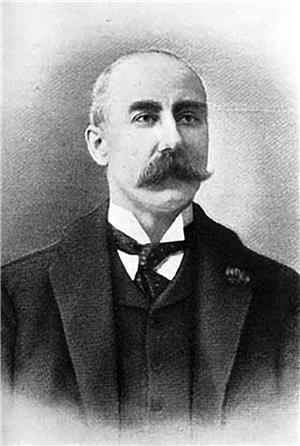The architectural firm of Charles Herbert Bebb (1856-1942) and Louis Leonard Mendel (1867-1940) was, from the turn of the century until 1914, the most prominent practice in Seattle.
Charles Bebb
Born at West Hall, Mortlake, Surry, England, on April 10, 1856, Bebb received an impressive education, beginning with private instruction at King’s College in London and preparatory school in Switzerland. He studied civil engineering at both the University of Lausanne, and the School of Mines in London.
His professional career began in South Africa, where, from 1877 to 1882, he engineered the construction of the Cape Town-Kimberley Railway. When he came to the United States, he anticipated drawing on this South African experience and looked for work with the rapidly expanding American railway system. But he found work as a construction engineer with the Illinois Terra Cotta Lumber Company.
With this company, Bebb developed fireproofing technology, a pressing need in the late nineteenth century when fires plagued many American commercial centers. He excelled at the task, and in 1888, the firm of Adler & Sullivan asked Bebb's firm to provide fireproofing for the Auditorium Building, a prominent work of the well-known Chicago firm. Toward the end of the project, Adler & Sullivan asked Bebb to serve as the building’s supervising architect.
In 1890, Bebb came to Seattle to supervise the construction of the Seattle Opera House. Unfortunately for Bebb, this project quickly ended, never reaching construction. After a brief return to Adler & Sullivan, Bebb settled permanently in Seattle.
From 1893 until 1898 when he began his architectural practice, Bebb served as architectural engineer for the Denny Clay Company.
Louis Mendel
Born in Mayen, Germany, Louis Mendel came to the United States in 1882. Mendel began his architectural career in Cleveland, Ohio, first at the firm of Lehman & Schmidt, then with the Schweinfurth Brothers. Like so many others, Mendel moved West in the late 1880s, eventually reaching Puget Sound.
By 1889, Mendel formed partnerships with other architects, completing a number of local projects in Tacoma, Seattle, Port Townsend, Sehome (Bellingham), and Yakima. These projects included commercial buildings, schools, and other public works. The Diller Hotel on First Avenue is an example of Mendel’s work of this period. After the Panic of 1893, Mendel relocated to Los Angeles, where he lived from 1894 to 1898.
Bebb and Mendel
When he returned to Seattle in 1899, he began a working relationship with Charles Bebb, initially drafting in Bebb’s newly established firm. In 1901, they began their prolific partnership. Their works varied in style and type, and included:
- The Everett Theater, Everett, Washington (1900-1901)
- The Hotel Stander (1900-1901; destroyed)
- University Heights School, University District, Seattle (1902; altered)
- The Oriental Block, Seattle (1902-1903)
- The Schwabacher Hardware Company Warehouse, Seattle (1903-1905)
- The Seattle Athletic Club (1903-1904; destroyed)
- The William Walker house, Seattle (1906-1907)
- The Frye Hotel, Seattle (1906-1911)
- The First Church of Christ Scientist, Seattle (1908-1909; 1912-1914)
- The Washington State Pavilion at the Alaska-Yukon-Pacific Exposition, Seattle (1908-1909; destroyed)
- The Hoge Building, Seattle (1909-1911)
- Fire Station No.18, Seattle (1910-1911)
Their partnership ended in 1914.
Post-Partnership
Bebb soon joined with Carl F. Gould (1873-1939); their partnership yielded many significant Seattle public works. Mendel continued a small scale practice which included several large houses and a few commercial buildings.
Bebb faired better than Mendel, due in part to the scope of his efforts. Bebb enjoyed political connections and actively promoted the professionalization of architecture in the Pacific Northwest. He was a founding member of the Washington State Chapter of the American Institute of Architects (AIA), and in 1910 was elected an AIA Fellow. His work with Gould produced award-winning, nationally significant works such as the Art Institute of Seattle (1931-1933), now known as the Seattle Asian Art Museum.

